History
The very first steps of the community date back to 1986 when two Danes, Jørg Gaugler and Kaj Hansen, presented their vision of a sustainable community during an evening class, a form of adult learning whose Denmark has a long-standing tradition. A group of people was then spontaneously created, from which emerged in 1987 an association for the creation of a cooperative ecovillage in Aarhus, the Denmark’s second largest city.The ecovillage project has been developed by the collective divided into several thematic working groups: one of the shared objective identified by the community was to reach a population of about 500 inhabitants on a site which includes an agricultural area allowing food self-sufficiency (therefore requiring approximately 100 hectares).
The project was presented to the local authorities, which reacted very positively and proposed three possible locations: the municipality of Hjortshøj, whose inhabitants supported the creation of an ecovillage, was selected by the members of the project.
In partnership with the authorities, a local urban masterplan has been put in place to take into account the choices defined by the collective: the project should only include low-energy houses limited to two floors and gathered into housing group with different legal forms (private housing, cohousing or rental housing) in order to promote greater social diversity.
In 1992, the first group of inhabitants settled in the ecovillage called "Andelssamfundet i Hjortshøj" (in English "the cooperative of Hjortshøj"). Today, eight housing groups have been built and are home to around 300 people. The consultation for the installation of three more housings groups has been started and should bring the total number of inhabitants to 450 people.
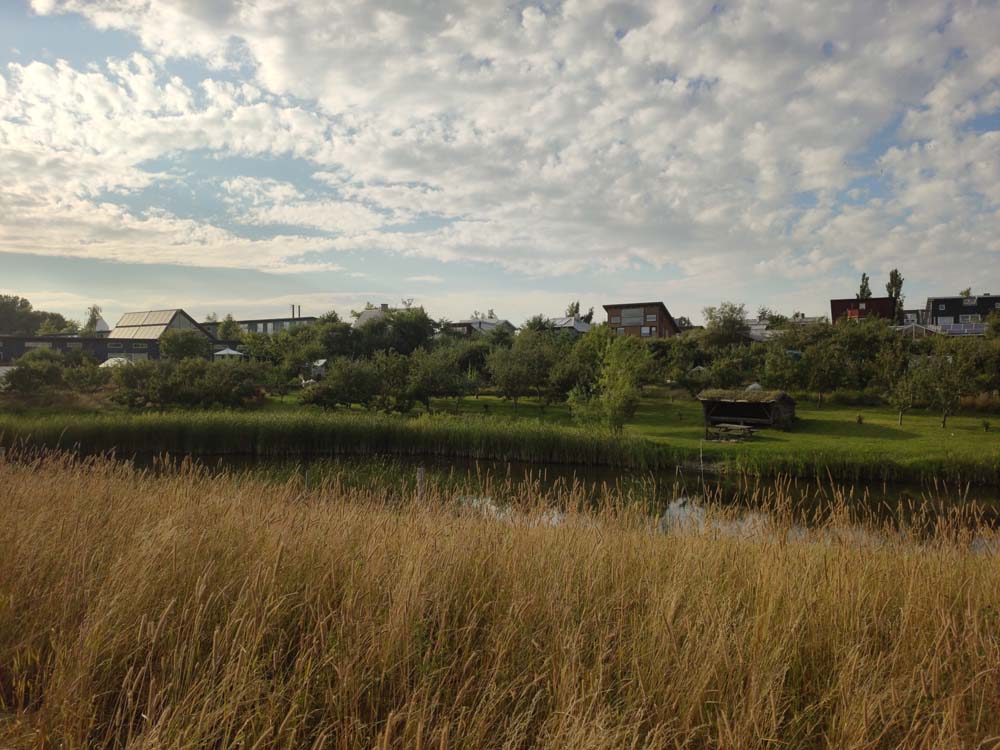
Andelssamfundet i Hjortshoj
Use of energy from renewable sources
Heat production
All the buildings in the ecovillage are equipped with solar thermal panels and hot water tanks for storing heated water. These panels provide 50% of domestic hot water needs over the year and 100% of needs from May to September.To cover the heat needs during the winter, the connection of the ecovillage to the district heating network has been investigated from the construction of the first houses: these district heating systems, of which Denmark is one of the pioneers (in total approximately 65% of Danish houses are supplied with district heat), consist of a system of pipes allowing the distribution throughout the city of the heat produced by several central boiling stations. Using district heating has undeniable financial and ecological advantages (as long as the heat is produced from renewable energy sources of course), in particular for Denmark, a large consumer of heat in winter.
The heat distributed on the Aarhus district heating network was largely obtained from boiler stations fuelled with coal in the 1990s: the community, which did not wish to heat itself from non-renewable sources, decided not to use the municipal heating network and, in 1996, created his own energy production company Energiselskabet: a heating network serving the 125 houses and apartments of the ecovillage was then built.
The heat necessary for the houses is produced from two biomass boilers, which are only started from September to May (the heat needs during the rest of the year being covered by solar thermal panels): the first boiler burns wood pellets (produced in Denmark from compacted sawdust and wood waste from the wood industry) and the second boiler, installed in 2003, uses woodchips (which are also waste from the forestry industry).
Several experiments were also carried out in the ecovillage:
- a Stirling engine, installed in combination with the boiler and using the combustion of wood pellets to run a generator and thus produce electricity, was tested in the community.
- an alternative heat distribution system has been developed for the housing groups the furthest from the heating plant: all houses of these housing groups have very low consumptions and then have limited heat requirements. Rather than maintaining a permanent circulation of hot water in the connection pipes between the boiler and the houses as it is usually the case, an impulse system has been set up: regularly during the day but for a limited time, hot water is sent to the houses of these housing groups. This hot water is stored into the houses and gradually released, which greatly limits the energy losses related to heat transport.
- the 2 boilers which produces heat for the community will be decommissioned in the coming months which arises again the question of connection to the district heating network: indeed, 100% of the district heat distributed on the Aarhus district heating system is produced from wood and straw, which matches the ecovillage objectives which intends to heat itself only from renewable sources. However, the ecovillage wants to remain a pioneer on this topic and now aims at providing its needed heat without burning any materials. A project to replace the boilers with heat pumps to recover energy from the ground (at the surface) to heat water is currently being studied.
As the idiom says, the best energy is the one that is not consumed! The community has applied this adage from the beginning with the construction of buildings whose thermal properties are ahead of the regulations in force: the maximum annual consumption per square meters of the first group houses was less than 50% of the current regulations. The one of the more recent housing groups is only reduced by 20% compared to standards, national regulations having been strengthened in the last decades.
To reduce energy overconsumption in houses, the heat supplied to the different houses is only billed based on the consumption in kWh (there is no fixed cost, such as a subscription): it motivates the community members to optimize their energy consumption.
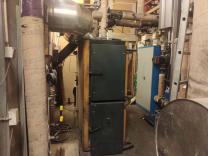
Boiler
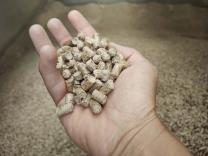
Wood pellets
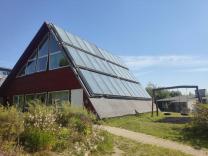
Solar panels
Electricity production
Some homes are individually equipped with photovoltaic panels allowing local energy production.Apart from the energy produced by the few photovoltaic panels installed in the ecovillage, the local production of electricity has so far not been identified as a priority, given that the energy production in Denmark is largely made from renewable sources (wind power covers up to 50% of the country's electricity needs).
Protection of cycles of water
The protection of cycles of water has been identified from the beginning as an important aspect of the project.With regard to wastewater treatment, the first housing group has been equipped, from its construction, with composting toilets with urine separation: as the inhabitants thought that it was less fertilizing than faeces, urine was evacuated with the grey water to the municipal sewerage system. The faeces were collected and spread as fertilizer in a willow plantation. The wood obtained was intended to feed the woodchip boiler heating the ecovillage.
After 15 years of use, this system was finally abandoned for various reasons (design problems favouring odours, insufficient spacing between the rows of willows in the plantation preventing the mechanization of tree cutting, impossibility of spreading faeces as fertilizer on certified organic plots, psychological barrier to manage the excrements of other community members...) and the houses, which were already connected to the municipal sewage network, have been equipped with low-flush toilets.
Composting toilets have also been introduced in other housing groups, but most houses have since been upgraded to flush toilets due to various design or organization issues.
The grey water from housing group #3 is still evacuated to a willow forest: the waste water is captured by the roots of the willows, which demand a lot of water, and the grey water contaminants (nitrates and phosphorus) are broken down and used by willows for their growth.
One third of the willow plantation is cut each year: the wood produced, which was initially intended for being transformed into chips to supply the boiler but was requiring too energy-intensive drying before its use, is now intended for other uses.
Each housing group also has access to a common laundry, which enables to invest in more robust and efficient equipment. It also limits the building area of each house as it avoids planning one laundry room per dwelling.
In addition, the common laundries use rainwater collected from the roofs and stored in tanks. Using rainwater to wash clothes reduces the amount of washing powder used, since soft water does not limit the effectiveness of laundry as opposed to hard tap water.
Finally, the rainwater collection, the installation of low flow taps in houses and user behaviour also allow a consequent reduction in the water consumption of the ecovillage.
Food production from organic agriculture
Twenty hectares of land adjacent to the ecovillage are currently rented to the municipality of Aarhus: this area is intended to cereal, fodder, fruits and vegetables production and livestock farming (currently chickens, goats and pigs).The community collectively manages these lands and about fifteen groups of inhabitants work on a voluntary basis for the operation of many agricultural activities on these lands: honey production, eggs, cereals, fruits, vegetables...
They have also been supported, since 2012, by some disabled people working for the Vimby Foundation (see the paragraph concerning Respect of diversity and development of a community vision in the Social section for more information), allowing them to be better included in the society.
Market gardening
On a 1.2-hectare area, market gardening is probably the agricultural activity that gathers the most community members: around 100 families participate in the activity.The operating principle is simple: in exchange for the payment of an annual membership (around €170 per adult) and a contribution to the market gardening activity (up to 20 hours per year), each person is free to harvest all the vegetables they need for their personal consumption.
Thus, each member is responsible for an activity: some do the sowing, others do the transplanting or weeding... The assembly of these 20 annual hours participations allows the organic production of many vegetables in large quantities. And it works perfect! During the summer months, the area is covered with many plants providing the community with potatoes, celery, parsley, beets, cabbage, leeks, carrots, onions, beans, fennel, corn, squash, lettuce...
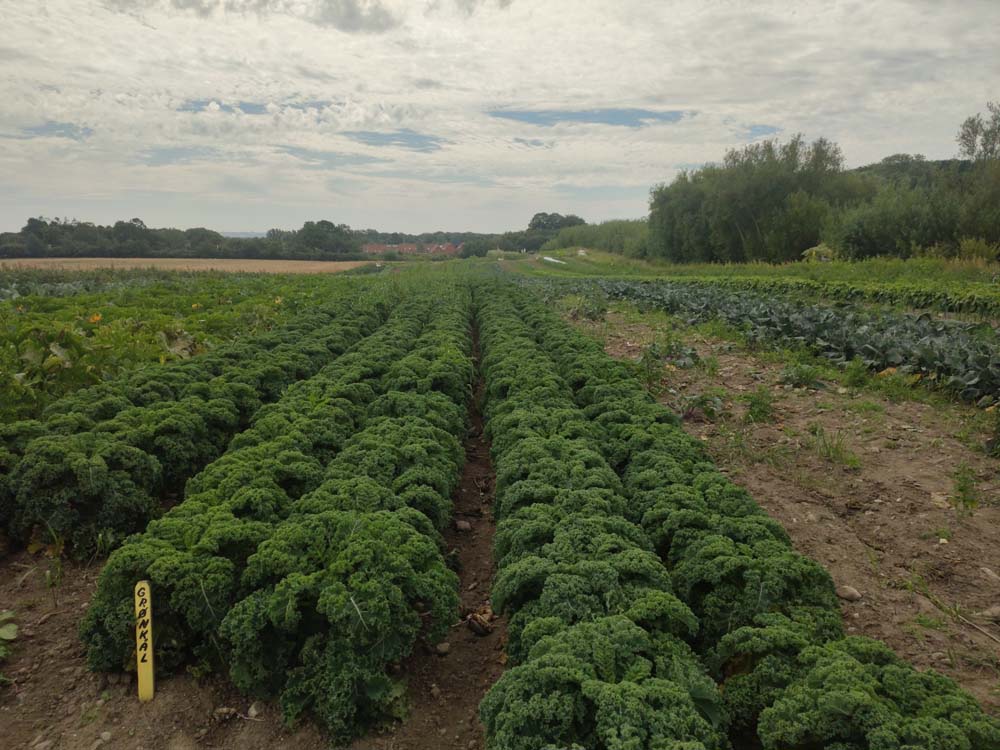
During the summer months, the land is covered with many vegetables, here kale
Other agricultural activities
Several other agricultural activities are practiced on the 20 hectares of land adjacent to the ecovillage. In order to improve soil fertility, rotations between activities and agroecological methods are implemented.The following agricultural activities are carried out:
- the cereal production performed by a team of volunteers. The harvested cereals are used, in part, to feed the community: the wheat produced is for example sold to the flour mill supplying the bakery of the ecovillage.
- egg production carried out by a team of volunteers who take turns every day with the help of disabled people employed by the Vimby Foundation: around 190 eggs are produced every day, to the delight of residents and neighbours of the community who can come and buy them! The hens, housed in a mobile henhouse, are regularly moved to different plots of the ecovillage.
- breeding, very popular in the ecovillage especially with children, allows the community members to consume meat produced locally and in full knowledge of the conditions of life and death: until 2019, a cow farm has been carried out but was abandoned as it was too time-consuming. Pigs, whose meat is sold in the community grocery store, are still raised in the ecovillage.
- the production of honey thanks to several beehives installed on the land
- the production of apples, the sale of which allows the regular planting of new trees
It should also be noted that in addition to the common market gardening activity, some inhabitants wanted to cultivate their own vegetable gardens: thus 3,000 m² of land were dedicated to around twenty individual vegetable gardens, from 25 to 250 m².
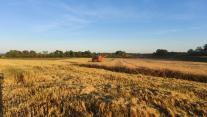
Wheat harvest
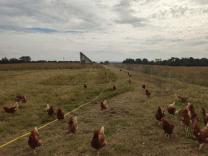
Hens
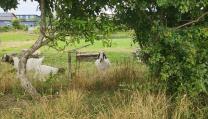
Goats
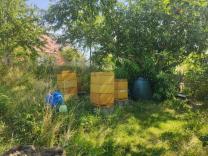
Hives
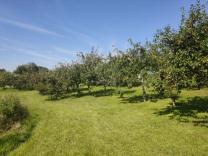
Orchard
Construction of sustainable buildings
Since its inception, the vision shared in the Hjortshøj community in terms of construction has been to "create a community of healthy and inspiring houses while respecting the environment".Over the years and using a wide variety of building techniques and materials, the 8 housing groups have followed the same approach, consisting of 6 guiding principles:
- the use of ecological building and insulation materials
- sustainable construction methods
- limitation of the use of resources
- low energy consumption
- a healthy indoor environment for its occupants
- waste reduction
From the beginnings of the community, a long work of experimentation has been carried out by the inhabitants. This work has enabled the acquisition a big knowledge which is now widely shared with collectives in the process of creation and in search of inspiration!
Before initiating the construction of the first housing group, the founding members have had to demonstrate to the municipal services that it was possible to build houses by using sustainable building techniques and materials. Indeed, the city services, which were not familiar with these techniques, did not believe that the proposed construction methods would meet the environmental standards then in force.
It is for this purpose that in 1990 a show house, called Petersburg ("Peter's Castle", named after one of the members who coordinated the construction) and which now serves as a meeting room for the community, was built by the collective: a construction company, Økotech, was also created by the inhabitants in order to support current and future building activities. The requests of the municipality, initially received as additional constraints, were finally perceived very favourably by the inhabitants: they indeed allowed the collective to deepen and improve the construction project.
In 1991, in the wake of the validation of the building techniques and materials by the municipality, the first plot was purchased and the construction of the first housing group, largely self-built, was launched.
The following building groups were also often built by their inhabitants themselves, in order to limit the building costs.
Sustainable materials and building techniques
Green building materials and techniques
The various buildings in the ecovillage are mostly built by using two different techniques: earth and wood construction.Earth construction
A large part of the houses from the first 3 housing groups are earth structures where the rammed earth method was used: rammed earth is an ancient method consisting in the compression of mixture of soil into formworks by successive layers of ten centimetres using a pneumatic tamper.
Rammed-earth walls are then externally insulated and protected by wooden cladding.
In order to facilitate the construction of the walls of some houses, an alternative technique has been implemented: unlike rammed earth, blocks of raw earth were prepared beforehand in a compacting machine provided for this purpose, to be then taken and installed on site. This more flexible and faster implementation method has benefited from the experience of traditional Danish brickyards.
Rammed earth has many advantages: its mechanical resistance allows the construction of the load-bearing walls of the house and its high thermal capacity is useful to store the energy of the sun during the day and to restore it at night. It is also a very good regulator of humidity in the house.
Its implementation also has the advantage of using the earth resulting from the excavation needed to build the foundations of the building: it is therefore a free raw material, local and which does not require heavy preliminary treatments (such as fired bricks which require a lot of energy to be produced for example).
These walls are very sturdy and will last over time if properly protected. Given the construction materials used, they will not produce waste at the end of their life and will gradually return to the earth under the effect of weather.
Timber-framed construction
A majority of the buildings in the most recent housing groups of the ecovillage were not built with raw earth but are timber-frame constructions.
Like rammed earth, wooden frame houses have many advantages: they are strong constructions and the wood acts as a thermal and humidity regulator, significantly improving interior comfort for the occupants.
It is also a durable material, provided that only local wood not treated against fungicides is used: to enable this, certain naturally protected wood species (such as thuja or larch) must be preferred and several techniques of protection, previously very commonly used such as the orientation of wood planks, had to be reproduced.
In addition to wood, houses built with a timber-frame have often been plastered with raw earth, providing a comfortable indoor environment.
Insulation
Several types of insulation have been installed in the houses.
The first housing groups were mainly insulated with cellulose insulation, made from recycled paper treated with fire-retardant chemical and fungicidal additives (ammonium salt and boric acid).
This form of insulation has good moisture transfer capacity, enabling a good indoor climate. In addition, it is a material that can be supplied locally and the ecological footprint of this insulation is limited compared to traditional insulation: its production requires between 20 and 40 times less energy than the production of standard mineral wool.
The most recent groups of dwellings have mainly used wood fibre and its derivative wood wool. This fibre comes from spruce from Scandinavian FSC certified forests, making it a local material. In addition, it is the only insulation that can naturally return to nature at the end of its cycle of use, without requiring specific human treatment as is the case for other types of insulation.
Wood fibres are a very good insulator having a significant thermal capacity, allowing to release heat inside buildings later (this will therefore delay the entry of heat into the home during summer and restore heat of the day during the night in winter). Like cellulose insulation, wood fibres are very good moisture regulators.
Ecological paints
Especially useful for wood and masonry protection but also for their aesthetic functions, the paints used in Andelssamfundet i Hjortshøj are natural. These paints have natural sanitizing properties and allow humidity regulation, thus ensuring protection of the walls while allowing them to breathe.
Several types of paints were used: linseed oil paints, widely used in Scandinavia for several centuries, have been used to paint wooden claddings, woodworks, windows and doors. These natural paints are made from ingredients such as linseed oil, wheat and rye flours and natural pigments.
Whitewash, whose recipes are ancient, is also used in the ecovillage for interior and exterior painting of clay walls: it is obtained by mixing lime, water, pigments and natural additives.
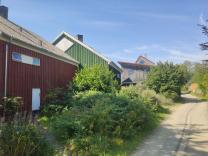
Housing group #1
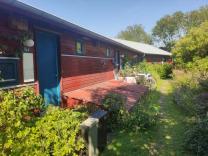
Housing group #2
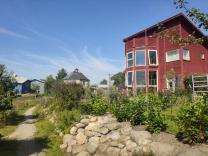
Housing group #3
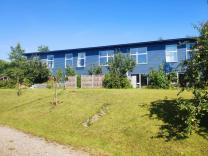
Housing group #4
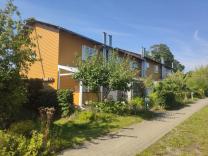
Housing group #5
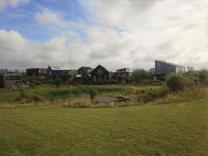
Housing groups #7 and #8
Reduction and reuse of waste
Even before talking about waste treatment, the community seeks to reduce its waste production: the organic grocery store installed in the ecovillage is a real advantage as it allows the purchase of food in large quantities, which are then repackaged on site in paper packages or available to residents with their own containers.Several other solutions have also been developed to limit the production of waste:
- an upcycling centre has been installed in the ecovillage: in this very popular building, objects that are no longer used are collected and put them on sale at a very low price, to find them a second life!
- a repair workshop is open every Wednesday morning: for half a day a week, several volunteers cheerfully repair the objects left by the residents or helps those who wish to learn how to repair by themselves. The diversity of objects restored is impressive: household appliances, garden tools, bicycles, everyday objects, electrical appliances ... the skills of the team are wide!
Regarding waste, the community tries to treat it locally and, when not possible, to sort it on site in order to direct it to the suitable reprocessing.
For biodegradable waste, food waste is dropped-off in individual composts that everybody is free to use. Green waste (grass clippings, leaves, etc) is brought by everyone to a specific area in the ecovillage provided for this purpose, so that they can be slowly composted there.
Denmark is one of the European champions in terms of waste treatment: 3 sorting bins, allowing the recycling of a lot of waste, are already available to all citizens (residual waste, plastic/glass/metal, paper/cardboard), and the residual waste is burnt in incineration plants with very strict environmental standards and producing heat and electricity.
Other waste (electronics, batteries, ceramics, etc.) must be deposited in municipal landfills: in order to limit the individual displacements of each inhabitant between their home and the landfill, several sorting centres have been created in the ecovillage and are managed by different working groups. Each week, a different family is responsible for taking the different categories of waste to the recycling centre, limiting the number of trips to the recycling centre.
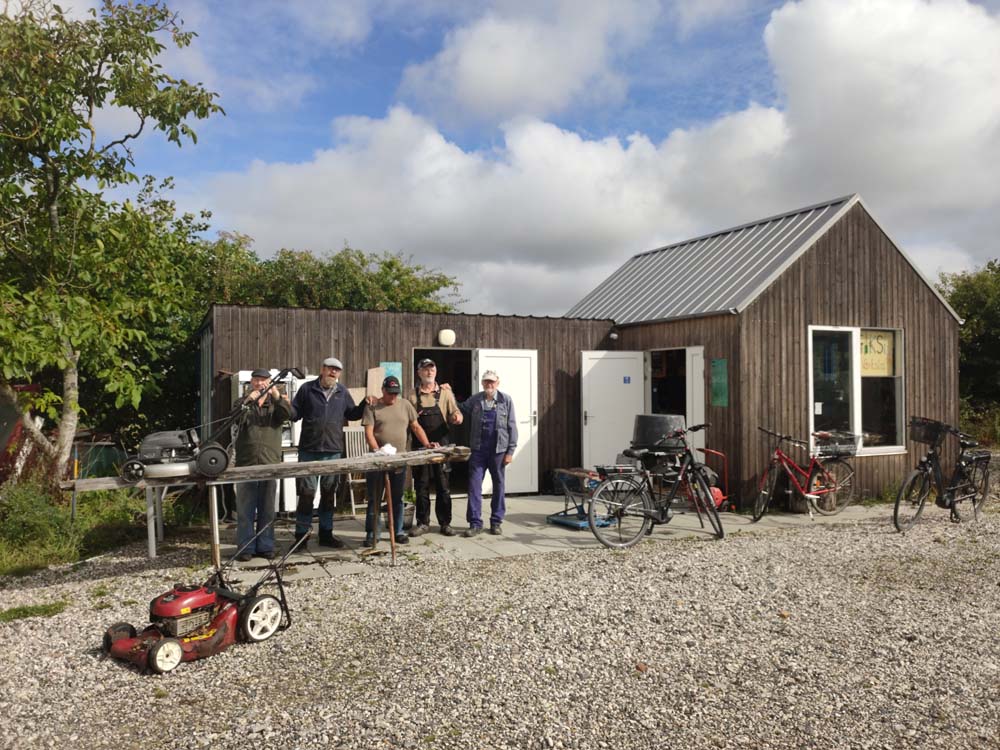
The repair workshop team welcomes anyone who needs to patch up an object with a big smile!
Protection of biodiversity and regeneration ecosystems
Throughout the development of the ecovillage, a special attention has been paid to the preservation of natural and wild spaces: three ponds are available for a variety of wild flora and fauna and the planting of the willow forest, which is now left wild, is a refuge for many species.Within the living area itself, natural spaces have been made available to animals and plants of all kinds.
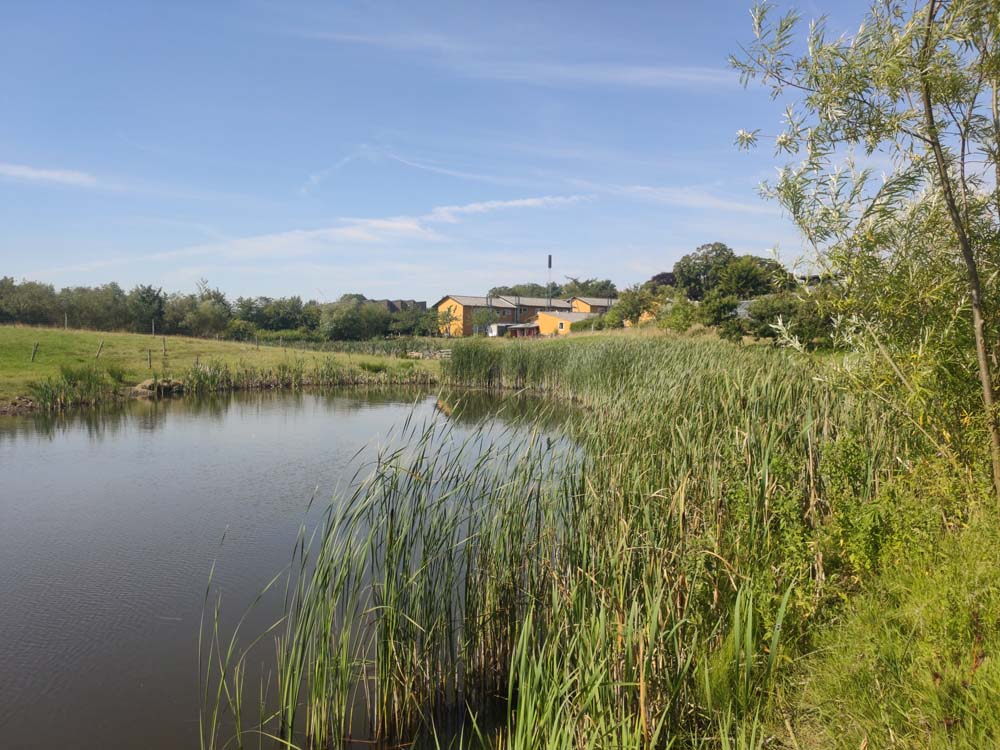
One of the ponds of Hjortshoj is the refuge of a large number of animals
Promotion of public transportation systems
Andelssamfundet i Hjortshøj benefits from its close proximity to Aarhus, Denmark's second largest city. Indeed, the ecovillage is only 10-minutes walk from the train station allowing to be in the city centre in around twenty minutes. A real boon for the inhabitants of the ecovillage!Beyond the use of public transport, when needed by the inhabitants of the ecovillage, a car-sharing service was created in 2014: for around 3,000 Danish crowns per year (around €400) and a rental based on the number of kilometres travelled (which however remains less interesting than the price of public transport not to compete with them), it is possible to use one of the fossil-fuel or electric cars available.
This system is particularly advantageous, both financially and environmentally, and allows an important number of the families of the ecovillage to avoid the purchase of a second car.
Respect of cultural traditions
Many traditions have been established in the community at different levels.Each housing group defines its own rules: the organization of common meals is for example more frequent in some groups which share meals several evenings per week when others only meet once a week.
In addition to the construction of a collective history where everyone learns to take care of the others, these shared meals enable the inhabitants to have discussions related to their life in community in a less formal way and are an effective communication tool within the group: they maintain the climate of trust that reigns in the ecovillage.
Several cultural traditions have also been created to regularly gather the whole community. Every Wednesday from 10:30am, some coffee and freshly baked bread from the Vimby bakery are served, allowing local people to meet for a friendly moment.
Annual festivals are also an opportunity to meet: the festival of lights is for example celebrated in Andelssamfundet i Hjortshøj to mark the approach of the winter solstice and the return of light. A march with lanterns is organized and ends with the distribution of a soup accompanied with songs and stories for children in Petersburg, the ecovillage's common room.
At the end of August, a big neighbours' party is organized: the members of the different housing groups play against each other through several games and share a meal together, allowing newcomers to be better integrated and to get to know people who belong to different housing groups.
Finally, for New Year's Eve, several inhabitants offer a comic retrospective of the projects carried out by the collective during the past year: this very warm presentation brings with a lot of humour a feeling of great cohesion in the community.
Several parties open to the public are also organized throughout the year. For several years, the ecovillage organized a weekend festival in May where many concerts and debates were planned, attracting several thousand visitors, especially from Aarhus. The profits made by this festival have greatly contributed to the establishment of the disabled inclusion project Vimby.
The harvest festival, held on the first Sunday of September, has also become a tradition in the ecovillage: every year, a festival and a market are organized to celebrate the harvest. Activities are offered as well as sales of local products and food and drink stands are set up.
Involvement to protect communities and nature
A way to raise awareness of an alternative way of life
The community of Andelssamfundet i Hjortshøj has, from its beginnings, played a pioneering role on many topics in order to defend a way of life that is more respectful of people and nature.The collective have had to argue the municipality services for having many new technologies accepted: rammed-earth constructions, use of cellulose insulation and non-treated wood, composting toilets, collection of rainwater for domestic use, creation of an independent heating network...
These numerous non-standards characteristics have also provoked the reluctance of banks to offer loans for the construction of the first houses. It was only after a long process of persuasion that loans at very high rates (around 9%) were obtained!
In order to disseminate the solutions implemented at Andelssamfundet i Hjortshøj more widely and inspire as many people as possible, a large number of awareness-raising projects have been proposed for a wide audience:
- when the first groups of houses were built in the 1990s, a partnership was created with the local employment agency so that unemployed people could come and participate to the construction of buildings and be trained in alternative construction methods.
- several international workshops were also organized, during which dozens of young volunteers from all over the world were able to discover the ecovillage and its community life, while participating in concrete projects.
- conferences were regularly held by several members of the community, in Denmark but also in France at Sciences Po Rennes.
- the visits offered once a month are also a way of making people outside the project aware of the challenges of tomorrow and the existing solutions.
- the ecovillage website , offering a wealth of information and feedbacks, is of great interest to anyone looking for more detailed information about the community and is undoubtedly a precious asset for any collective under creation.
A need for not being isolated from the rest of the society
One of the values identified in the community’s first agreement was that the ecovillage "grows through mutual influence with the rest of society".The community has always paid a closed attention not to stray from the rest of the society: the location of the ecovillage was, for example, of capital importance, as the inhabitants wanted to invest sufficient land to allow a certain food autonomy while remaining near the city of Aarhus.
The question of setting up a school in the ecovillage was discussed in the 1990s: the decision was finally that the children would go to public school so as not to break off all ties with the rest of the municipality.
Many ecovillage activities are also aimed at both community members and neighbours: the grocery store and the various workshops (the recycling centre or the repair shop for example) are open to everyone.
The ecovillage was and still is also in regular contact with the municipal services: this has, for example, enabled the community to participate to the successive local urban masterplans, in order to include the community needs in terms of construction of new building groups.
Celebration of life and diversity through art
The ecovillage benefits from an important artistic offer through numerous workshops and regular exhibitions.Several workshops have been installed in the community: for example, a small trailer is now in the community's gardens and several artists meet there regularly to share their experiences and exhibit their creations.
A pottery workshop was also recently installed after a suggestion from a resident of the community.
About ten artists also exhibit their creations every week in a gallery built in the heart of the ecovillage.
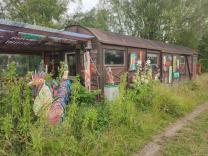
Artist workshop
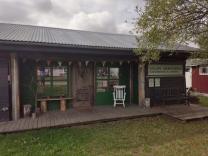
Artists gallery
Reconnection with nature
The community intended to create paths on the ecovillage area where everyone could walk to enjoy nature, allowing them to discover the biodiversity of meadows, ponds and forests.In a spirit of openness to the rest of the society, these paths are open to all and it is quite common to see families from the neighbourhood coming to have a walk on the community paths.
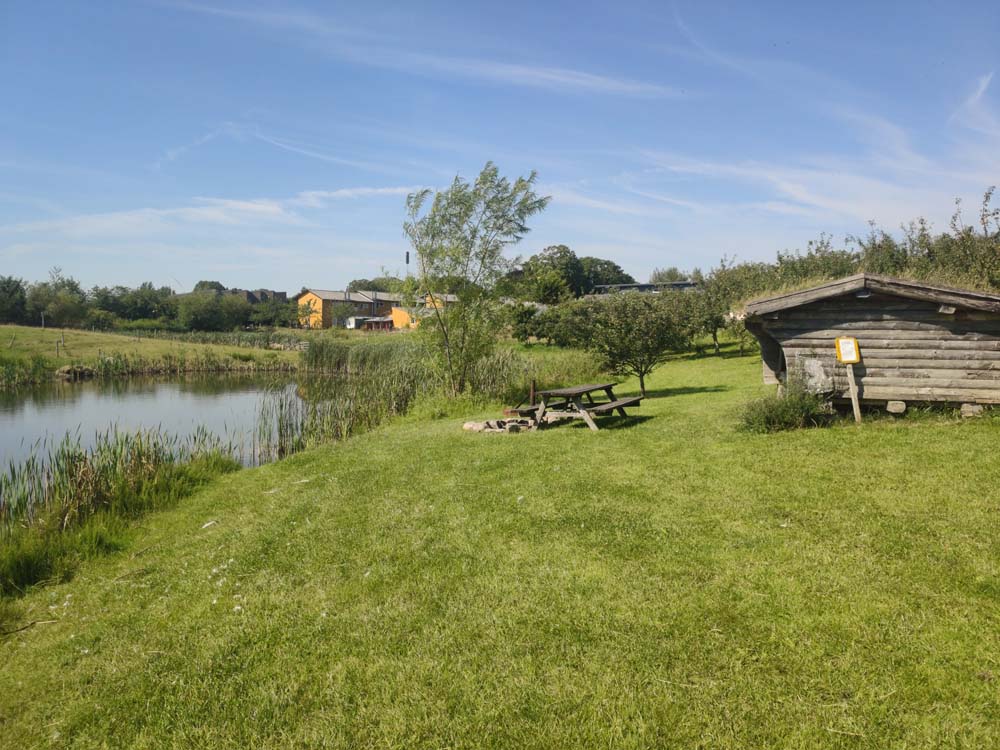
A shelter has been installed near one of the ponds of the ecovillage, allowing young people from the community and the surroundings to spend summer evenings around the fire
Guarantee of equitable ownership of land and resources
The ecovillage of Hjortshøj has the particularity of having been developed in stages, through the construction of successive housing groups: each group has chosen the most suitable economic-legal structure, resulting in a diversity of forms of ownership.Thus, 3 housing groups are private accommodation, as each family is the owner of its own house and the land on which it is built. A fourth housing group has a slightly different legal structure, still based on private housing: in this group, 10 families occupy 5 different houses, each family sharing the building with another one. In each house, the 2 families are in participatory housing and have taken out a joint bank loan for the construction of the house.
Three housing groups are rented: two groups are social housing owned by two major social landlords in Denmark, the inhabitants are therefore tenants of their apartments. All apartments of group #6 are rented and occupied by 16 disabled people.
Finally, a housing group of 17 units is in participatory housing, a common form of legal arrangement in Denmark. In participatory housing, the different owners do not personally buy their homes: a company is created on this occasion and each person becomes a partner of this company through the purchase of shares. When one of the inhabitants moves out, that inhabitant's shares must be sold to the next person.
Promotion of social entrepreneurship
In the early 2000s, an inclusion project for around twenty disabled people enabled the creation of several economic activities in the heart of the ecovillage through the Vimby association (see the paragraph concerning Respect of diversity and development of a community vision in the Social section for more information). A grocery store was thus created as well as food production workshops.An energy production company, organized as a cooperative, produces the heating energy needed for homes from two wood-fired boilers.
Wealth creation through sharing and collaboration
Voluntary cooperation to activities
The Hjortshøj ecovillage is the result of a long cooperation work between its members whose commitment has always been considered to be voluntary: apart from certain mandatory tasks (such as the cleaning of common houses), everybody is free to commit to the community up to their desires or possibilities, which allows a greater motivation of the members.The ecovillage inhabitants organize many activities on a voluntary basis, with the support of working groups. About forty groups currently exist, with among others:
- production of many products: eggs, cereals, pork, honey ...
- production of vegetables carried out by a hundred families working together (for more details see the paragraph concerning Food production from organic agriculture in the Ecology section)
- car-sharing service
- management of recycling-centres
- organization of parties and other cultural activities
- the organization of guided tours in the ecovillage
The development of these voluntary activities is strongly encouraged in the community, provided that the project is economically viable in the long term, so that it does not become a burden for the community.
Any proposal to create an activity, presented to the community at a monthly meeting, is never refused: it can sometimes be asked to specify the project when questions are not resolved. In this case, arrangements are often made to help emerging projects and new working groups regularly obtain financial support to make the initial investments needed to set up the activity.
Conversely, an activity which can no longer find enough volunteers to be continued will not be maintained at any costs: volunteers, whose work is particularly respected, have no problem withdrawing from a project they were involved in when they no longer have time to devote to this activity. This is the case, for example, with cattle breeding which was stopped in 2019, as the community was not able to find volunteers to take over from those in charge until then.
In order to support these voluntary activities and participate in the life of the ecovillage, each member pays an annual membership fee of 1,500 Danish crowns (approximately 200 euros). These funds make it possible to make an initial investment in new voluntary activities, to organize cultural and social activities in the ecovillage and to fund some non-profitable agricultural activities.
In the past, it has also been used to finance legal aid for a new housing group which needed assistance to define its legal status.
Pooling of resources
Sharing resources is an important element for the members of the Hjortshøj ecovillage and takes many forms.Thus, all the housing groups had their common houses built with a reception room, a laundry room, a large kitchen and a guest bedroom. These rooms, which are only useful occasionally, are not required to be built in each dwelling, allowing a consequent saving of space.
As presented in the paragraph concerning the Promotion of public transportation systems in the Ecology section, a car-sharing service has been set up and enables to limit the number of personal cars purchased by the ecovillage inhabitants.
Likewise, a large number of tools are pooled:
- large equipment, such as scaffolding, is made available to the entire ecovillage by a working group
- smaller equipment (mowers or screwdrivers) are shared on smaller scales within housing groups
Responsible production, consumption and trade
Several economic activities of production and consumption have been developed in the ecovillage by members who have created their own self-entrepreneurial activity.This is the case of Michel, who makes traditional Italian ice cream in a workshop that was made available to him in the ecovillage with ingredients that he selects carefully. He sells his ice creams all summer long every Friday afternoon in the community.
Michel has also built a mobile pizza oven in a horse trailer, which allows him to distribute pizzas in the region. One evening a month, the inhabitants are used to meet in the ecovillage and share together some pizzas prepared by Michel, a very convivial event!
As previously indicated, the disability inclusion project led by the Vimby association has allowed the construction of food production workshops (including a bakery that makes bread four times a week) and a grocery store, called Høkeren, which sells many organic and, where possible, local products, as well as products repackaged by some of the disabled employees.
The eggs produced by the hens of the ecovillage (between 150 and 200 eggs per day) are available in a fridge where, in the climate of trust specific to Denmark, everyone is free to help themselves by paying the corresponding amount in a money box.
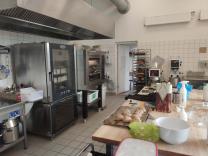
Production workshop
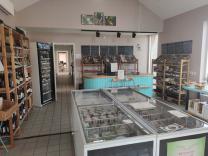
Grocery shop
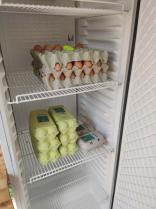
The eggs store
Respect of diversity and development of a community vision
A common vision in the community
From 1987 when the group of people interested in the creation of an ecovillage in Aarhus was formed, several working groups have regularly met to explore various topics related to community life. A first charter presenting the common vision of the community has emerged from these meetings: this charter specifies, without indicating strict constraints, the objectives of the community and its governance.It was also planned that this charter would be revised on a regular basis, so that it can always reflect the current objectives of the community: a revision was thus carried out in 2007, followed by another one in 2016.
The documents presenting the community values can be consulted on this page .
No inclusion process is planned in this community in order to maintain the common vision of the collective when new members arrive, which makes it very open.
On the other hand, the current inhabitants can guide the vision of the new housing groups being formed in order to maintain the common objectives of the community. Indeed, during the creation of new housing groups, the group of future inhabitants will meet regularly during a long process, to define its own rules concerning the construction of dwellings (What materials will be used to build the houses? Do we put fences between the gardens? etc) and the organization of the common life (How often do we meet? What are the uses of the common house? etc). During these meetings, current members are often invited to talk about their experience and inspire the future inhabitants, thus making it possible to better disseminate the values of the community to the future inhabitants.
A great diversity of community members
One of the key values of the ecovillage is "to create the necessary conditions so that a real community can develop between people of different ages and backgrounds".One of the means implemented to develop a social mix within the community was to launch a social housing project in the ecovillage, allowing access to inhabitants with lower incomes.
The first step of this project was to find a social housing landlord interested in building ecological social housing in the ecovillage, while enabling the future inhabitants to participate in the development of the project. This search was long and complex as all social landlords generally seek to build standard housing projects for reduced costs, which can first be considered hardly compatible with ecological housing built in consultation with the future tenants.
A social landlord, named Lejerbo, finally agreed to get involved in the project. A one-day "workshop for the future" gathering architects, the potential future inhabitants and several employees of the social landlord was organized: the future inhabitants were thus able to participate in the development of the project by submitting their ideas concerning their future housing, so that these ideas can be integrated into the building plans.
Some compromises have been necessary but the majority of the green building objectives of the community were achieved, despite the limited budget of the social landlord, thus allowing people with modest incomes to benefit from the environment provided by the ecovillage.
Following this remarkably successful first experience, a second housing group was built through a cooperation between the ecovillage and the social landlord Ringgården, which has now become a specialist in the sustainable construction of social housing.
Close collaboration between members of the ecovillage and social landlords has enabled, in the case of housing group 2 at least, to select the first residents of the dwellings according to a list established by the ecovillage, and not following the classic selection of social tenants: thus, the group of future inhabitants who had formed from the beginning of the project and who had participated in the development of the project could live there.
However, the allocation of dwellings in the two social housing groups is now done via the traditional selection made by the landlords: families who are not aware of ecology and who do not necessarily agree with the ecovillage principles therefore integrate these housing groups. It is a chance to integrate more social diversity in the community but can also be a risk for the group, if the objectives of everyone are too divergent.
Finally, in the early 2000s, a group of residents worked on the development of a disabled people inclusion project in the ecovillage through the Vimby association, which was created to carry this project: indeed, Vimby is the abbreviation for Velkommen I Min BYdel, "welcome in my neighbourhood" in English. Thanks to public and private funds, a group of adapted housing as well as new buildings have been built in the heart of the ecovillage: the approach followed is the reverse inclusion, which consists in integrating the living space of disabled people directly at the centre of the community. The aim is to make them feel like ordinary people and not to isolate them in separate structures.
The buildings created include the community's grocery store and food production workshops in which several handicapped person daily work with educators and volunteers: they fully participate in the community life and produce various foodstuffs, which are then sold. in the grocery store.
Guarantee of participatory leadership and shared governance
The decision-making of Hjortshøj ecovillage is very shared and decentralized, which is probably facilitated by the great trust in each other that Danes have by nature.Several decision-making levels exist in the community: housing groups, working groups and the management board.
Housing groups are the very first entity of the ecovillage, gathering a group of inhabitants around rules defined during the development of the project and which make them live collectively on a daily basis. Each month every group meets: these meetings are an opportunity to spend convivial collective moments and also to discuss topics related to the life of the group and the ecovillage. Each housing group appoints a representative who sits on the ecovillage management board.
The working groups are the backbone of the ecovillage activity: they bring together members of different housing groups around specific activities such as egg production or car-sharing service. They are responsible for setting up the activity they are in charge of and for its economic viability.
The majority of initiatives and decisions are taken in housing groups or working groups.
On the other hand, decisions concerning the ecovillage as a whole are taken at a monthly meeting which gathers all the community members.
The management board is responsible for making effective the decisions taken during the monthly meetings and for coordinating the relations between all the groups in the ecovillage: it does not normally have a decision-making role.
Whatever the level of decision-making, the vast majority of decisions are made on the basis of consensus.
Use of communication skills, conflict facilitation
As Danes are culturally very conciliatory, a calm and serene debate in which everyone is free to express their ideas can generally be conducted, which greatly limits the emergence of conflicts.In addition, everyone strives to be as transparent as possible when making decisions: for example, everyone is free to attend all meetings, thus creating a climate of trust in the community.
This climate is reinforced by the fact that the housing groups and work groups are small, allowing everyone to get to know the people with whom they work.
More practically, the community uses the internet platform Borigo for its daily communication: Borigo is a Danish digital communication tool made available for housing cooperative projects, quite common in Denmark.
It allows to:
- inform the rest of the community via messages published on a digital information board
- create and lead groups of members (groups of residents and working groups in this case for example)
- communicate directly with the neighbours via a messaging system
- manage shared resources, such as rooms, tools or household appliances (such as common washing machines)
- to gather documents and make them available to other members
It has nevertheless happened in the history of the community to experience situations where communication was no longer possible: in these moments, interventions of professionals were requested in order to set up the mediations necessary to solve the situation.
If you are travelling in the area, there are several ways to discover Andelssamfundet i Hjortshøj:
- Visits of the ecovillage are regularly organized: they normally take place one Saturday a month and last approximately two hours. For 60 DKK (approximately 8 euros), you will be able to discover the main places of the community and share a coffee or a drink in one of the common houses. To know the dates of visits and to have more information about them, you can visit this page (in Danish) or the /www.andelssamfundet.dk community Facebook page
- If you do not have the possibility to go to an organised visit, you can still discover the grocery store of the village "Høkeren" as well as the artist's gallery, the upcycling centre or the ice cream truck. For opening hours, visit this page (in Danish) or the Facebook page of the ecovillage shops
- If you are in Aarhus in September, it may be an opportunity to attend the harvest festival celebrated by the community on the first Sunday in September. You will be able to discover the ecovillage and discuss with the inhabitants. Many activities are organized for the occasion and a sale of local products, drinks and other food is offered.
- Are you looking for temporary accommodation near Aarhus (a very beautiful city, a must-see if you're visiting Denmark)? Guest rooms are available in the ecovillage: you will take the place of the inhabitants of the ecovillage who have left for holidays and will thus have the opportunity to discover the ecovillage from the inside. More information on this page (in Danish)
 Country
Country
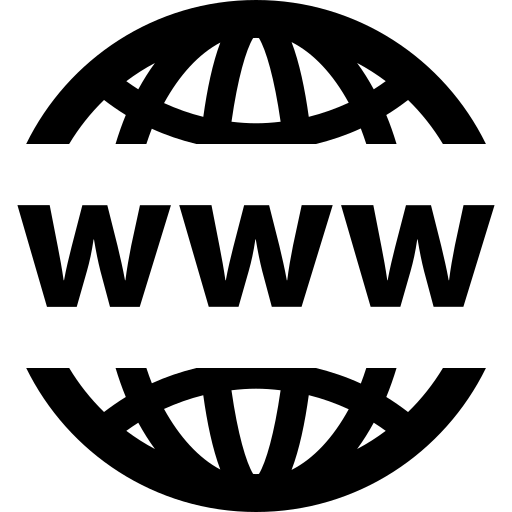 Website
Website
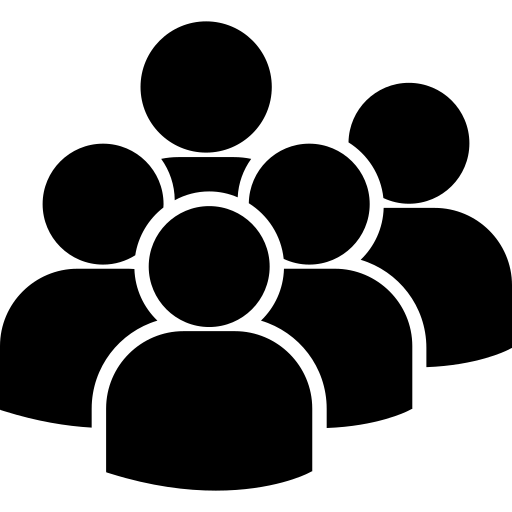 Number of Inhabitants
Number of Inhabitants
 Date of Creation
Date of Creation